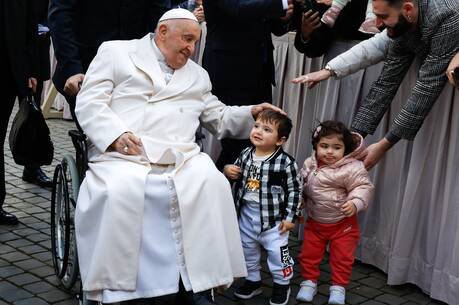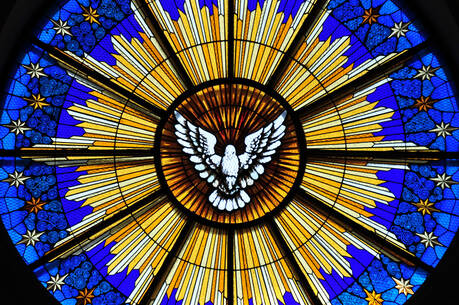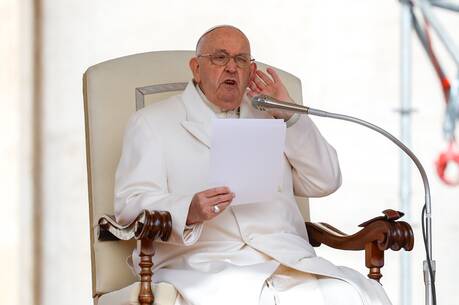Have you heard the one about the confirmation liturgy at which a liturgical dancer presented the gifts to the bishop? After receiving them the bishop turned to the pastor and said, If she asks for your head, she can have it! This allusion to the story in Mark’s Gospel about John the Baptist and the daughter of Herodias elicits laughs from clergy and laity alike. As for me, a Jesuit priest who has worked for the inclusion of dance in the liturgy for the past 30 years, I can join in the laughter; but I must honestly say I do not find the joke all that funny. It reveals a bias against a form of religious expression that can be an authentic form of prayer and praise, as it is rooted in the psalmist’s invitation to praise God’s name in the festive dance (Ps. 149).
To associate a contemporary liturgical dance, done as a symbolic offering by a young woman, with the infamous dance of Herodias’s daughter that brought about the beheading of John the Baptist prejudices the answer to the question, Shall we dance? Despite all the many positive scriptural references to dance as a form of prayer and worship, one of the two most negative biblical references is invoked. (The other is the story of Israelites dancing before the golden calf [Ex. 32:19].) Ironically, the Scripture passage from Mark (6:17-29) that speaks of the young girl’s dance may be one of the most misinterpreted.
The Gospel text does not give the name or age of the young girl. (We know her name, Salome, from the Jewish writer Josephus.) It does not describe the kind of dance that she did, but the presumption is that her dance was seductive. Dance is about sex and irrationality and can produce dire consequences! In her excellent exegesis of this text in the journal Semeia (Calling the Shots, 1996), Alice Bach concludes that the dance of Salome was much more innocent than interpreters have suggested.
Sometimes I think I have lost my head, devoting so much of my ministry to dance as a way of prayer and worship. For years I have heard the jokes, the critiques and the condemnations. And yet I cannot ignore the scriptural exhortation to praise God with timbrel and dance (Ps. 150). Nor can I forget the words of David to his critic Michal after he danced before the ark: It was before the Lord, who chose me before your father, and above all his house, to appoint me as prince over Israel, the people of the Lordand I will make merry before the Lord (2 Sam. 6:21).
Although there are no prohibitions in the Bible against dance, and in spite of many positive invitations to this form of praise and worship, the contemporary attempt to restore dance as an authentic form of religious expression has met with significant resistance.
When I first discovered the beauty and power of dance to communicate religious meaning, I naïvely thought that I would find universal acceptance for this form of prayer and praise. After all, don’t we use dance forms, such as the procession, in all of our liturgies? Don’t we hear the psalmist exhort us to praise God with timbrel and dance? Don’t we profess belief in God who became flesh in Jesus Christ, so that our bodies, our whole selves are blessed? Doesn’t the resurrection of Jesus make us want to jump for joy and leap for love? Don’t the texts of our liturgical music sing of a dancing people of God? Let us build the city of God,/ may our tears be turned into dancing! (City of God, Dan Schutte).
Over the years my enthusiasm has been tempered by documents from Rome that reinforce the bias that in Western culture dance is associated only with entertainment and courtship. These notices from Rome disregard the tradition of folk dance in Western culture and deny the possibility of creating a form of movement that can express authentic religious sentiment.
It is not my intention here to apologize for dance in liturgy. Whether dance finds a place in our worship as part of the larger choreography of liturgy is secondary to how we might reclaim the spiritual dimensions of dance in our lives of faith. The question Shall we dance? is an invitation to reflect on how we can affirm a human experience that from the beginning of time has had power to express the pains and joys of human life and that has been for some an avenue to the divine.
I would like to offer some thoughts that emerge from my experience as a presider and leader of prayer and as one who has worked with young and old alike in opening the experience of prayer as an expression of the whole person through movement and dance.
Full, conscious and active participation. These words from the document on the liturgy from the Second Vatican Council are surely among those most often quoted by liturgists and pastors as they try to encourage animation of the whole assembly. It is challenging enough to achieve this participation in music and other forms of acclamation. It is quite a different story to invite the entire assembly to dance! And so, the custom has been to use individuals from the assembly who have a facility for dance to embody the prayer for all. The principal critique here is that the dancers are doing performance, while liturgy is meant to be prayer. And yet isn’t it the nature of ritual leadership to perform? Effective presiders, preachers, soloists and choirs are such because they are good performers. Liturgy is by nature a dialogue between performance and prayer.
When I first began choreographing dances for the liturgy in the 1970’s, I was so enraptured by dance as an art form that the dances I produced were lovely to look at and often inspiring, but they belonged more in a performance venue than in the assembly gathered for worship. When I began to preside at liturgy in the 1980’s, I became more conscious of the principle of integration and flow of the whole prayer. If dance were going to be a part of the assembly’s prayer, it would be simple and transparent in its meaning. It would also be one dimension of the prayer of the people, working with musical expression and ritual action. Experience tells me that dance can have a powerful role in our liturgy if it is always at the service of the ritual, animating the minds and hearts (and even the bodies) of the whole people of God gathered for worship.
Alternatives for worship. Another lesson I have learned in my work in dance and worship is that Sunday liturgy may not be the best place for it. This is not because the ritual does not explicitly call for it, but because the ritual of the Mass as we celebrate it in our Western culture already has much movement in its choreography for presiders, lectors, ministers and assembly. There are not many moments in the liturgy where dance can find a place, but it may be used to give life and spirit to the opening or the Gospel procession or as an interpretation of the psalm refrain. (Special rituals like the Easter Vigil offer more possibilities for the inclusion of dance.)
My own work has focused on other forms of communal prayer, such as evening prayer. Each Holy Week in our church we offer an evening prayer that is solely music and dance, using trained dancers and members of the parish who have participated in Lenten workshops on movement prayer. In this form of worship, which is structured on the model of the Liturgy of the Hours, dance is the primary mode of prayer throughout the service. Those who come to the service actively participate with simple gestures and dance. It is a remarkably powerful experience to witness a whole community moving together in time and space.
Embodied prayer. Over the past 25 years I have offered retreats and workshops that invite people into the experience of movement prayer. I never cease to be amazed at how powerful and grace-filled this experience is for someone who thinks of prayer as simply a mental activity. The body has an innate language that can give expression to a range of human emotion. When individuals connect this language of movement with their experience of God, it is a true epiphany. The life-giving spirit of God animates the person in such a way that he or she experiences a freedom in prayer not known before in the same way. This focused concentration of movement and meditation finds expression in Eastern religious practices like yoga and tai chi. I believe that there could be a more explicit connection between body-mind and spirit in our Christian tradition; we do not have to be disembodied in our prayer. There is a choice. If we look deeply enough into our mystical tradition we can find the groundwork for a prayer that engages the whole body.
Earthen, sacred vessels. We are taught that our bodies are sacred vessels, images of God, redeemed by the love of Jesus Christ. Paul speaks of our bodies as temples of the Holy Spirit. Our bodies are our way of being in this world and our way of responding to God’s overtures of love. And yet there are many negatives that influence our body images. Size, shape and sexuality are just a few. The work I have done in enabling people to claim movement and dance as a form of prayer has made a difference in the way people see themselves and their being with God. For this reason, I am amazed at the negative reaction to liturgical and sacred dance. Through dancewhose intention is to give praise, reverence and service to Godthe person affirms his or her body as a gift from God.
Double standards. Over the years I have been inundated with criticism of liturgical dance from those who say that it is forbidden by Rome or in a particular diocese and from others who say that it belongs only in the theater, not in the sanctuary. But there is a double standard. On World Youth Day in Rome last year, a photograph was taken of Pope John Paul II flanked by prelatesand two dancers posed in front of them. If dance can be part of this special celebration presided over by the pope, why are there so many objections in local dioceses and parishes when people want to use this form of prayer and worship for some special occasion?
The other double standard is the distinction between people who come out of Western civilization and others for whom dance is part of their cultural expression. Who has not experienced a joyful communal dance at a wedding reception? There is a tradition of folk dance in Western civilization that is not about entertainment or courtship. Dance can be a celebration of life. It should not be summarily dismissed as an inappropriate way of celebrating God’s life and love.
Through the door named Beauty. In an article in America by Cardinal Godfried Danneels, The Contemporary Person and the Church (7/30/01), the author speaks of truth, goodness and beauty as three access roads to God. He wonders whether we are using sufficiently one of the doors that leads to Godthe door named Beauty. He goes on to say that Beauty has as yet been explored very little in theology and catechesis in our day.
I believe that dance is one of the most beautiful forms of the expression of the human spirit. It is interesting that the word we use to describe God’s self-communication, grace, is the word used to describe much of dance. Graceful is the movement of body and spirit!
I believe, too, that dance can communicate the deepest longing of the human spirit and the ecstasy of divine love. It is not surprising that the mystery of God’s incarnation in Jesus Christ has been portrayed in poetry as a dance:
Tomorrow will be my dancing day.
I would my true love see the legend of my play.
O my love, my love!
This have I done for my true love.
Shall we dance? My suggestion is that we let God take the lead.







